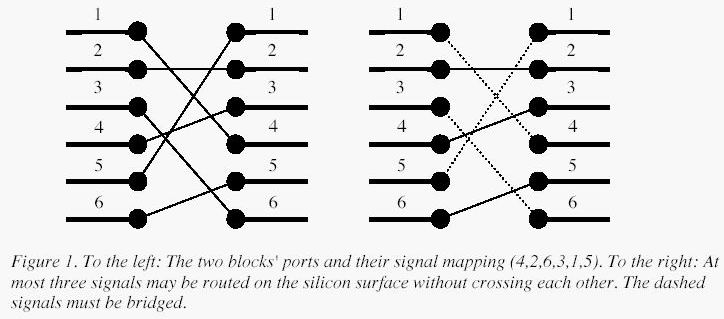POJ 1631 Bridging signals(LIS 二分 快速方法)
2014-10-19 15:40
387 查看
| Language: Default Bridging signals
'Oh no, they've done it again', cries the chief designer at the Waferland chip factory. Once more the routing designers have screwed up completely, making the signals on the chip connecting the ports of two functional blocks cross each other all over the place. At this late stage of the process, it is too expensive to redo the routing. Instead, the engineers have to bridge the signals, using the third dimension, so that no two signals cross. However, bridging is a complicated operation, and thus it is desirable to bridge as few signals as possible. The call for a computer program that finds the maximum number of signals which may be connected on the silicon surface without crossing each other, is imminent. Bearing in mind that there may be thousands of signal ports at the boundary of a functional block, the problem asks quite a lot of the programmer. Are you up to the task?  A typical situation is schematically depicted in figure 1. The ports of the two functional blocks are numbered from 1 to p, from top to bottom. The signal mapping is described by a permutation of the numbers 1 to p in the form of a list of p unique numbers in the range 1 to p, in which the i:th number specifies which port on the right side should be connected to the i:th port on the left side.Two signals cross if and only if the straight lines connecting the two ports of each pair do. Input On the first line of the input, there is a single positive integer n, telling the number of test scenarios to follow. Each test scenario begins with a line containing a single positive integer p < 40000, the number of ports on the two functional blocks. Then follow p lines, describing the signal mapping:On the i:th line is the port number of the block on the right side which should be connected to the i:th port of the block on the left side. Output For each test scenario, output one line containing the maximum number of signals which may be routed on the silicon surface without crossing each other. Sample Input 4 6 4 2 6 3 1 5 10 2 3 4 5 6 7 8 9 10 1 8 8 7 6 5 4 3 2 1 9 5 8 9 2 3 1 7 4 6 Sample Output 3 9 1 4 Source Northwestern Europe 2003 |
seach就是找寻以a[i]结尾的序列会有多长,然后就更新
代码:
#include<iostream>
#include<cstdio>
#include<cstring>
#include<algorithm>
#include<cmath>
#include<queue>
#include<stack>
#include<vector>
#define L(x) (x<<1)
#define R(x) (x<<1|1)
#define MID(x,y) ((x+y)>>1)
#define eps 1e-8
using namespace std;
#define N 100005
int a
,c
,n;
int seach(int len,int x)
{
int le=0,ri=len,ans=0,mid;
while(le<=ri)
{
mid=(le+ri)>>1;
if(c[mid]<x)
{
ans=mid;
le=mid+1;
}
else
ri=mid-1;
}
return ans;
}
int main()
{
int i,j,t;
scanf("%d",&t);
while(t--)
{
scanf("%d",&n);
for(i=1;i<=n;i++)
scanf("%d",&a[i]);
int len=1;
c[1]=a[1];
for(i=2;i<=n;i++)
{
if(a[i]>c[len])
{
j=len++;
}
else
j=seach(len,a[i]);
c[j+1]=a[i];
}
printf("%d\n",len);
}
return 0;
}
相关文章推荐
- Poj 1631 Bridging signals(二分+DP 解 LIS)
- Poj 1631 Bridging signals(二分+DP 解 LIS)
- HDU 1950 POJ 1631 Bridging signals【LIS,二分优化】
- POJ - 1631-Bridging signals (LIS二分模板题)
- poj 1631 Bridging signals (LIS 最长递增子序列 DP-二分)
- [POJ](1631)Bridging signals ---- LIS+O(nlogn)优化(二分)
- POJ 1631 Bridging signals(LIS 二分法 高速方法)
- poj 3233 Matrix Power Series(矩阵快速幂+二分求和)
- poj 3233 矩阵快速幂 + 二分求和
- POJ 1631 Bridging signals 解题报告(附详细分析)最长上升子序列的dp+二分
- POJ - Matrix Power Series 【矩阵快速幂+二分求和】
- 最长递增子序列 (Longest Increasing Subsequence, LIS),POJ 2533, POJ 1631
- poj 1845 Sumdiv(数论:欧拉函数+二分求等比数列前n项和+快速幂取模)
- poj 1845(快速幂+二分计算等比数列和+大数因子分解+因子和计算+模除溢出)
- poj 1631 Bridging signals 最长上升子序列的O(n*lgn)方法
- POJ 1631 Bridging signals(LIS+二分)
- POJ 1631(O(nlogn)LIS的2种做法)
- poj 1631 Bridging signals (二分||DP||最长递增子序列)
- POJ-1631 Bridging signals LIS
- POJ-1631-Bridging signals-( 水LIS-O(nlogn) -DP)
